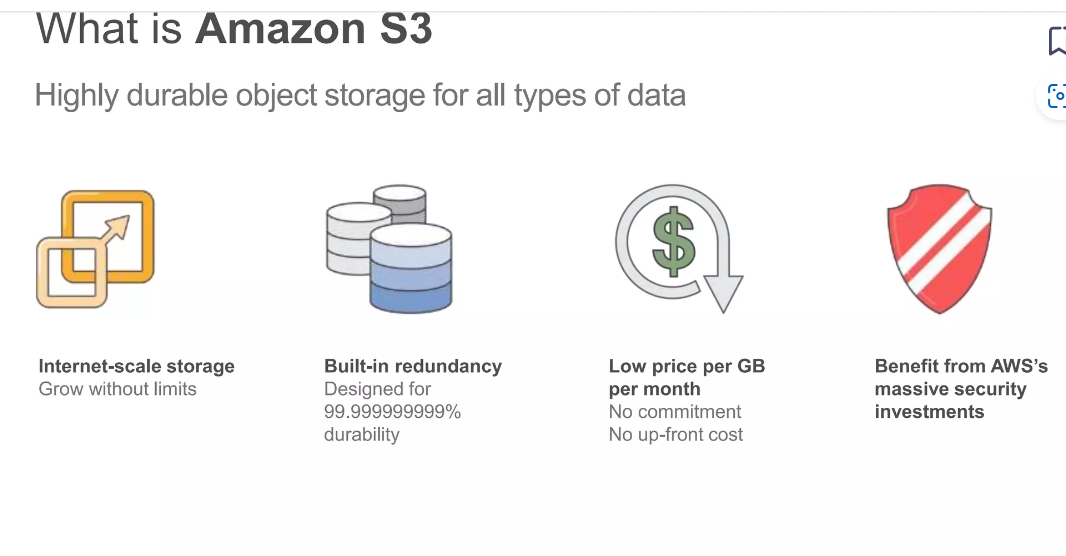AWS Mastery On S3 Course for Zero to Hero
AWS Mastery on S3: Zero to Hero

Section 1: Introduction to Amazon S3
1.1 What is Amazon S3?
1.2 History and Evolution of Amazon S3
1.3 Use Cases and Benefits of Amazon S3
1.4 Overview of AWS and S3 in the Cloud Ecosystem

Section 2: Setting Up and Navigating AWS Section
2.1 Setup AWS S3 Account
2.2 Navigating the AWS Management Console
2.3 Introduction to S3 Dashboard
2.4 Setting up Your First S3 Bucket Section
3: S3 Bucket Basics
3.1 Understanding Buckets and Objects
3.2 Creating and Deleting Buckets
3.3 Uploading and Downloading Objects
3.4 S3 Bucket Properties Overview
4.1 Amazon Storage Class
4.1 Storage Class Overview
4.2 Introduction to S3 Standard and Use Cases for S3 Standard
4.3 Pricing and Performance Characteristics
4.4 Best Practices for Using S3 Standard
4.5 Understanding Intelligent-Tiering
4.6 How Intelligent-Tiering Works
4.7 Use Cases and Cost Optimization
4.8 Monitoring and Managing Data in Intelligent-Tiering S3 Standard-Infrequent Access (S3 Standard-IA)
4.9 Introduction to S3 Standard-IA
5 : S3 Security and Permissions
5.1 S3 Security Fundamentals
5.2 Bucket Policies and IAM Roles
5.3 Access Control Lists (ACLs)
5.4 Understanding Public and Private Access Section
6: Advance Features on S3
6.0 Security on S3 Features for AWS
6.1 Encryption in Transit and at Rest
6.2 Data Compliance in AWS S3
6.3 AWS CloudTrail and S3 Server Access Logging
6.3 AWS S3 Transfer Acceleration
6.4 Monitoring AWS S3 with Amazon CloudWatch
Section 7: Security on S3 Features Continue
7.0 Advance Features on S3
7.1 Versioning in S3
7.2 Tags on AWS S3
7.3 Intelligent-Tiering Archive configurations
7.4 Event notifications
7.6 Requester pays
7.7 Cross-origin resource sharing (CORS)
7.8 Storage Class Analysis
7.9 Inventory configurations
7.10 Replication rules
7.11 Access Points
7.12 Lifecycle Management Policies
7.13 Cross-Region Replication (CRR)
7.14 Multiple Upload
7.15 Object Lock and versioning
Section 8: S3 for Web Hosting and Content Distribution
8.1 Hosting Static Websites on S3
8.2 Integrating S3 with CloudFront
8.3 Using S3 with Route 53 for DNS Managemen Section 9: S3 Data Security and Encryption
8.1 Encryption Methods in S3
8.2 Server-Side Encryption (SSE) with S3
8.3 Client-Side Encryption
8.4 Key Management Best Practices
Section 9: S3 Performance Optimization
9.1 Understanding S3 Performance
9.2 Best Practices for High Performance
9.3 Performance Tuning Techniques Using S3 Transfer Acceleration and Multipart Uploads and S3 Select
9.4 Using Amazon CloudFront with S3 for Optimized Delivery
Section 10: Integrating S3 with Other AWS Services
10.1: Integration with AWS CloudFront and Lambda
10.2: Using S3 with AWS Glue and Athena
10.3: Automating Workflows with S3 and AWS Step Functions
Section 11: Automating S3 Operations
11.1 Introduction to AWS Lambda with S3
11.2 S3 Event Notifications
11.3 Building Automation with S3 and Other AWS Services
Section 12: Monitoring and Logging in S3
12.1 S3 Access Logs
12.2 Monitoring S3 with CloudWatch
12.3 Audit Logs with AWS CloudTrail
12.4 Troubleshooting and Log Analysis Section 13: S3 Best Practices and Cost Management
13.1 S3 Cost Management Strategies
13.2 Data Transfer and Request Pricing
13.3 Reducing Costs with S3 Storage Management Features
13.4 S3 Cost Optimization Tools and Techniques
Section 14: Real-World Projects and Case Studies
14.1 Project: Building a Secure File Storage System
14.2 Project: Creating a Media Content Delivery Network
14.3 Case Study: S3 for Disaster Recovery
14.4 Case Study: Large-Scale Data Processing with S3 Section 14.3: Disaster Recovery and Business Continuity
14.1: S3 Cross-Region Replication (CRR)
14.2: Backup Strategies Using S3
14.3: Implementing Disaster Recovery Plans
